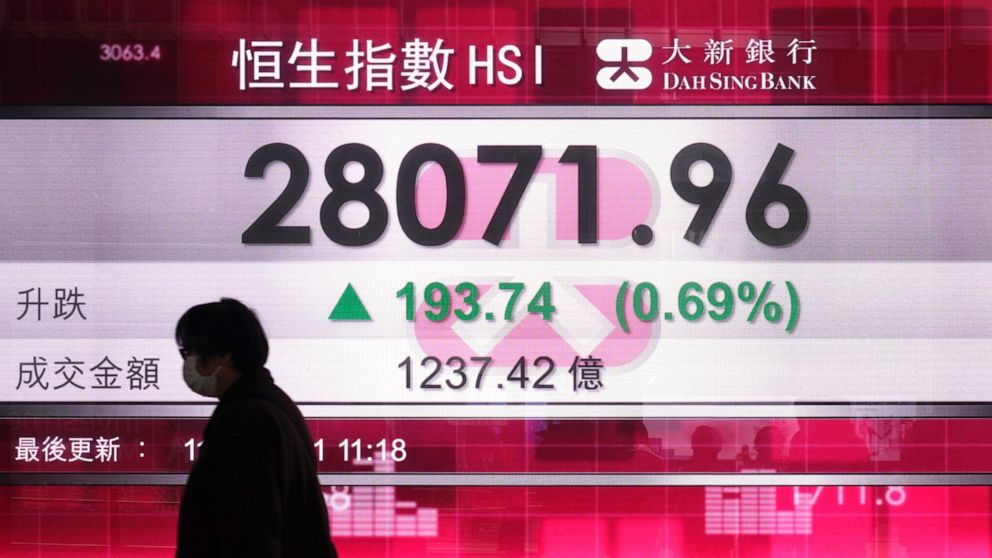Stocks slip as Wall Street takes a breather after 4-day run
NEW YORK — Stocks pulled back on Wall Street Monday as markets around the world paused following record-setting runs.
The S&P 500 fell 0.7%, breaking a four-day winning streak. Tesla, Amazon, Apple and other big gainers over the past year led the way lower, even as financial, health care and energy stocks notched gains. Treasury yields continued to rise.
Analysts said a pullback was no surprise following the big rally recently for everything from stocks to bond yields to commodities amid a wave of optimism. With Democrats set to take control of Washington, investors expect Congress to try soon to deliver more stimulus to the economy through larger cash payments for Americans and other programs. That’s building on top of enthusiasm already built about a powerful economic recovery coming later this year as COVID-19 vaccines roll out.
The market managed to look past much of last week’s bad news, including the attack on the U.S. Capitol on Wednesday, surging virus cases, and a disappointing employment report, said Julian Emanuel, BTIG chief equity and derivatives strategist. That both speaks to the market’s resiliency and could signal a change in attitudes.
“The fact that the market shrugged all of this news off, it’s ushering in a more speculative stage in the bull market,” he said.
The S&P 500 dropped 25.07 points to 3,799.61. The Dow Jones Industrial Average fell 89.28 points, or 0.3%, to 31,008.69. The Nasdaq composite slid 165.54 points, or 1.3%, to 13,036.43. The three indexes set all-time highs on Friday.
The market’s record-setting run means stocks and other investments are even more expensive, leaving critics to say they’ve gone too high. One of the main ways professional investors gauge a stock’s value is by measuring its price against how much profit it made in the prior 12 months. Stocks in the S&P 500 are trading at roughly 29 times their earnings. That’s a much more expensive price tag than their average over the last decade of a little below 18, according to FactSet.
“Given where we are in terms of valuation, there’s not going to be tolerance for news that isn’t good,” Emanuel said.
At the same time, the worsening pandemic continues to slam the economy. U.S. employers cut more jobs last month than they added, for example, the first month of job losses since last spring. New, potentially more contagious strains of the coronavirus are helping the pandemic to tighten its grip on the economy around the world.
In the background, political uncertainty also continues to hang over markets. Democrats are pushing for the removal of President Donald Trump, who has less than two weeks left in his term, after his words helped incite a group of loyalists to storm the Capitol last week.
“The equity markets remain forward-looking and focused on what is to come beyond the next 10-15 days,” said Bill Northey, senior investment director at U.S. Bank Wealth Management.
Shares of Twitter slid 6.4% for one of the largest losses in the S&P 500 after it banned Trump from his account and his 89 million followers. Twitter cited “the risk of further incitement of violence,” but the move has drawn a lot of anger from conservatives who may abandon the service and ask for more regulatory scrutiny of the company. Facebook fell 4% after it suspended Trump’s accounts.
Other areas of the market also lost momentum, but not by as much as social media stocks and Big Tech. Stocks of smaller companies fell, nudging the Russell 2000 index down 0.65 points, or less than 0.1%, to 2,091.01. It remains 5.9% higher for 2021 so far, more than quadruple the gain of the big stocks in the S&P 500. Investors have been rotating out of the winners of the stay-at-home pandemic economy and looking for potential winners of a recovering economy.
In the bond market, Treasury yields have been shooting higher, in part on expectations that the U.S. government is set to borrow a lot more money for stimulus programs. That has investors raising their expectations for economic growth and inflation. The yield on the 10-year Treasury climbed to 1.13% from 1.09% late Friday. It was just 0.89% at the end of 2020 after setting a record low during the year.
Higher long-term yields can put pressure on stock prices and make them look even more expensive. That’s because when bonds are paying investors more in interest to own them, they can pull buyers away from stocks. In general, higher interest rates make investors less willing to pay higher prices for stocks relative to their earnings.
Strategists at Morgan Stanley have been saying for months that bond yields may be set for a big rise, and they said in a report on Monday that stocks may have hit their peak for how much investors are willing to pay for each $1 of corporate earnings. That would put more pressure on companies to grow their earnings for their stock prices to rise further or even to hold steady.
Analysts expect strong profit growth to return for companies later this year as the economy recovers. But in upcoming weeks, when CEOs are scheduled to tell shareholders how much profit they made during the last three months of 2020, Wall Street expects to see a sharp drop. Analysts forecast S&P 500 companies to report a decline of nearly 9% in earnings per share from a year earlier, according to FactSet. If they’re right, it would be the third-worst drop since the summer of 2009.
European markets closed lower and Asian markets were mixed.
———
AP Business Writer Yuri Kageyama contributed.
![]()


